Simone Rocha AW24, Victorian Mourning Dress, & the Commercialization of Death
an opulent display of death and desire
When I die, I expect my love to wear black until the day we are reunited. Witnessing such a fervent exhibition of mourning serves as a poignant muse for a designer whom I know has a penchant for romanticizing the enigmatic and forbidden. I’m drawn to a romance steeped in shadows, enamored by Victorian attire, and captivated by the narrative conveyed through garments. Grief remains one of the most complex emotions to navigate and articulate. Yet, grief intersecting with beauty, vitality, and desire introduces an additional layer of intricacy. Rocha delved into a chapter of fashion history that grappled with, and triumphed over, the challenge of encapsulating one of humanity's most profound emotions. In “The Wake” she deftly reimagines its multiple dimensions.
The collection is the final part of a triptych that began with her Spring/Summer ‘24 collection, “The Dress Rehearsal”, followed by her collaboration with Jean Paul Gaultier, “The Procession”, for Paris Haute Couture. While researching Gaultier's archive stored in boxes labeled 'coffins', Rocha was invited to view Queen Victoria's mourning dress at Hampton Court palace, noting the contrast between mourning attire's protective symbolism and Gaultier's provocative designs.
A haunting blend of death and desire, the runway took place in St. Bartholomew’s Church, setting the eerie atmosphere for the collection. Viewing her designs go down the aisles of that medieval church, I began to reflect on my own recent qualms with death and religion. I decided this year that I would give up coffee for Lent. Although raised Catholic, I no longer align with the religion, yet this year, I felt compelled to give something up, to purge myself of something. I shared my dilemma with my sister, confused by the sudden need to partake in this practice. She replied, “I just love a ritual.” Finally, I understood the driving force behind my desire to cleanse—it stems from a desire for ritual and renewal.
For Rocha, mourning fashion, design, and display are all part of a ritual. This collection intertwines Victorian mourning attire with Rocha’s signature romanticism, encapsulating the dual nature of love and grief, and highlighting (whether intended or not) the enduring commercialization of death. As I dive into the history of Victorian mourning attire and its effects on fashion, I’m eager to explore how Rocha's AW24 collection incorporates elements of this somber yet captivating aesthetic, offering a contemporary lens on the rituals of mourning and remembrance.
Victorian Mourning Dress & It’s Influence on Fashion
Victorian Mourning attire evolved significantly through the 19th century, reflecting prevailing cultural attitudes towards death, grief, and social status. The Victorin era, spanning from 1837 to 1901, was marked by a rigid adherence to mourning rituals and customs. Following the death of Queen Victoria’s husband, Prince Albert, in 1861, the Queen’s deep mourning set a standard for the rest of society, influencing mourning practices for decades to come.
During the early Victorian period, mourning attire was characterized by strict dress codes, with widows expected to wear all-black clothing made from heavy, matte fabrics like crepe and bombazine. Women were required to veil their faces when in public, symbolizing their grief and withdrawal from society. As the mourning period progressed, widows could gradually introduce small embellishments like lace or mourning jewelry.
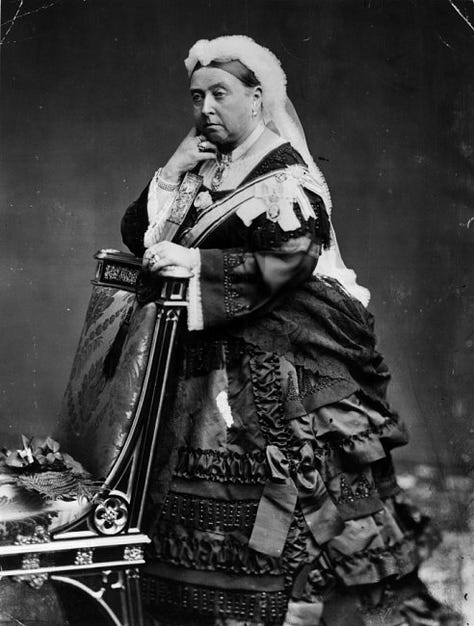
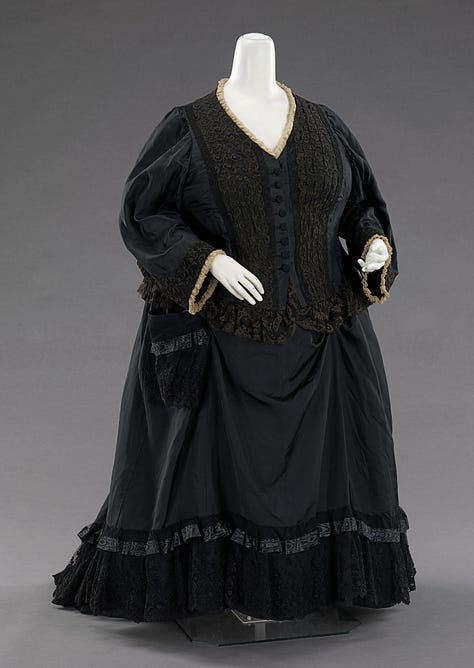
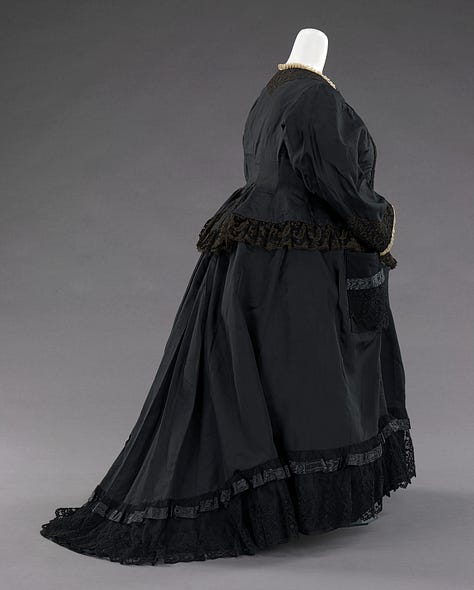
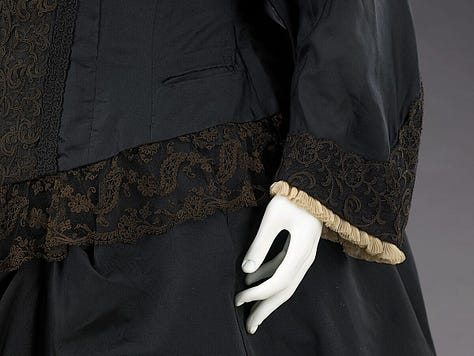
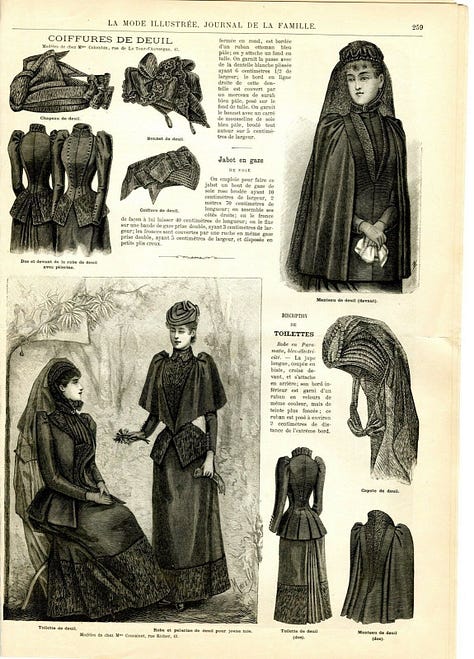

By the late Victorian era, mourning attire became slightly less restrictive in terms of style and fabric choices, although the symbolic significance remained paramount. Mourning clothes were still predominantly black, but lighter fabrics like silk and velvet were introduced, and veils became shorter and less opaque. Mourning customs became more standardized, with etiquette books providing detailed guidelines on appropriate mourning periods and attire based on the mourner’s relationship to the deceased. Various stages of mourning were established and fabrics were assigned to each stage. While mourning attire provided a tangible way to express grief, it also sparked criticism for its financial burden and class distinctions. Reusing clothing from prior mourning periods was considered socially unacceptable, leading to a surge in demand for specialized mourning attire during the Victorian era. Among the most renowned establishments catering to mourning wear was Jay’s of Regent Street in London.
The somber and intricate aesthetic of mourning has since influenced subsequent fashion movements, particularly in the use of dark colors, heavy fabrics, and understated embellishments. Elements like high necklines, long sleeves, and modest silhouettes reminiscent of Victorian mourning attire have persisted in contemporary fashion and are currently at the center of fashion subcultures like goth, emo, and punk. The Victorian emphasis on symbolism and storytelling through clothing has endured, with designers often incorporating themes of mourning, melancholy, and nostalgia into their collections as a means of exploring deeper emotions and societal commentary.
The Commercialization of Death
Mourning customs became highly commercialized during the Victorian era. The elaborate mourning dress, characterized by its dark colors and intricate detailing, served as a visual marker of grief and social status. It reinforced class distinctions, as the cost of mourning attire meant that only the wealthy could afford the most elaborate displays of grief. The commercialization of death during this period normalized and even glorified mourning, perpetuating a culture of grief that often prioritizes outward displays of sorrow over genuine emotional processing. The commercialization of death and mourning attire during the Victorian era also laid the foundation for modern fashion's relationship with morbidity and romanticism.
While mourning attire was once a societal necessity, its transformation into a marketable commodity has shaped the way death is portrayed and perceived in fashion today. Designers will draw inspiration from Victorian mourning customs, reimagining mourning attire and adding contemporary twists that when perceived and circulated by the internet and capitalism now fall under hyper-consumerist aesthetics like “dark academia.” “rocococore,” or “bimbo vampire.” It becomes difficult then, when it trickles down the fast fashion machine, to understand this fusion of historical influences with modern sensibilities as an enduring legacy of Victorian mourning attire on fashion's interpretation of mortality, memory, and emotional expression, or simply as the commodification of sadness in a culture where pain is too often romanticized.
(Styling) Notes on Simone Rocha AW24: The Wake
Below are the elements of Simone Rocha's Autumn/Winter collection that I believe most strongly resonate with their Victorian mourning roots, as well as some of the distinctive codes that characterize this collection as uniquely Simone Rocha. I've also included some notes on how to evoke the dark romance created by Rocha in this collection for those of us who may not have access to purchasing her pieces but still love to embody her aesthetic.
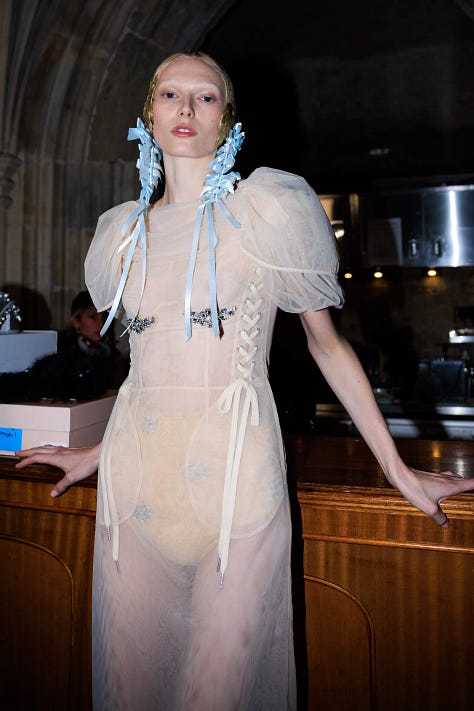
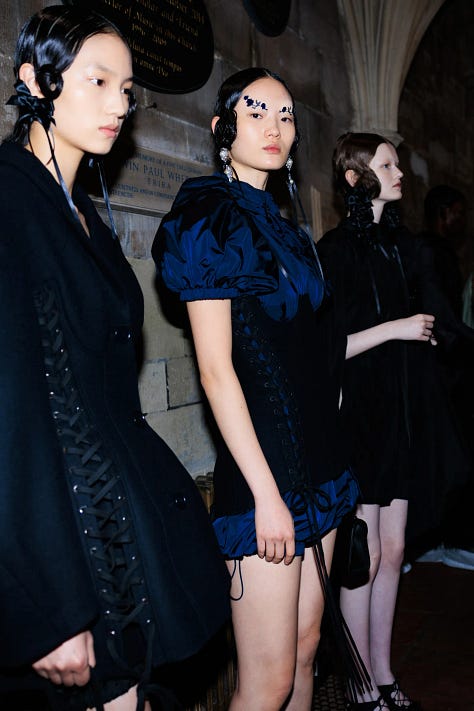
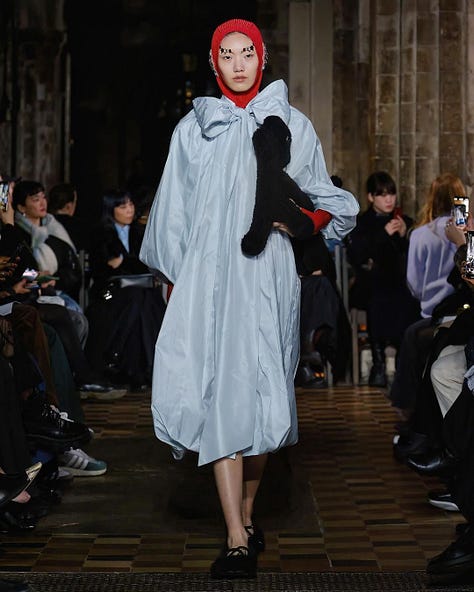

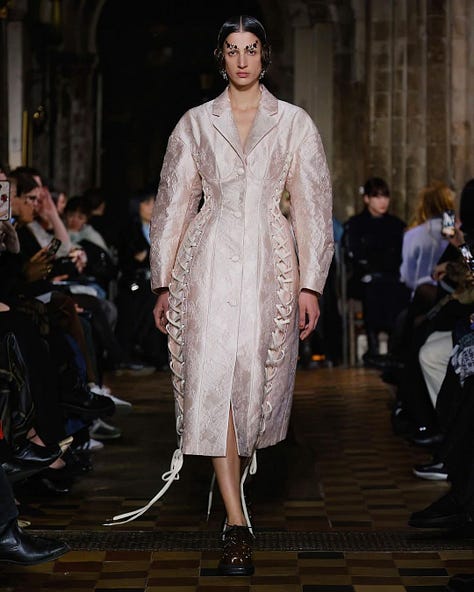
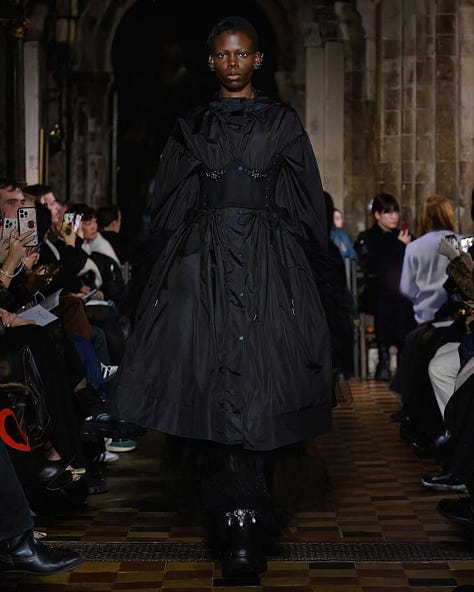

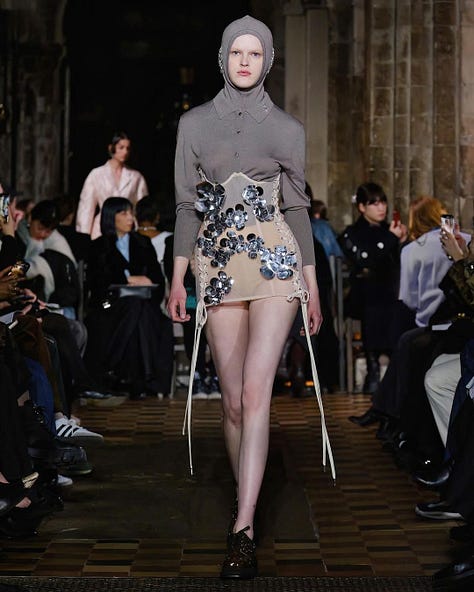
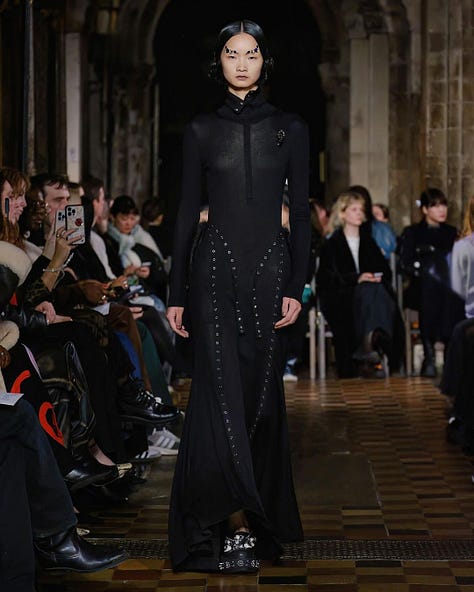
Corsetry: What stood out most to me about this collection is the corsetry. Beyond traditional corsets and boned skirts, corset details formed coats and knitwear. She told Vogue about viewing Queen Victoria’s dress and Jean Paul Gaultier’s archive, “I’d be in Hampton Court looking at these pieces that were all about security on the body and mourning as a front and form of protection, and then I’d be in Paris looking in Gaultier’s coffins at these super promiscuous perverse pieces,” further stating that what united the two was boning. The corset remains a symbol of restraint and underscores the history of Victorian fashion in this collection.
Layered & Slender Silhouettes: Rocha is known for her layering techniques, often stating that she layers to create volume, but she told British Vogue about this collection, “this time, I really wanted to see the pieces on the body…” hinting at the lengthened silhouettes and augmenting details around the hips and chest. The roundness of Queen Victoria’s mourning dress is inherent to Rocha’s design codes and to mourning dress in general, but the slender silhouette as a symbol of death is a much more contemporary interpretation of grief and fashion. Think Elvira or Drusilla from Buffy the Vampire Slayer. It’s also a much sexier understanding of darkness; which is fitting as this collection is born at the crossroads of death and desire.
The Church Grim: Rocha’s bags took on a more whimsy form this season, the form of the Church Grim. The Church Grim is a mythical creature in English folklore, often depicted as a spectral black dog that protects churchyards and warns of impending death. Legend has it that it either guards the souls of the departed or serves as a harbinger of doom. It’s been a while since I’ve seen stuffed animals deemed acceptable purses, but I find this form far more elegant and symbolic than the Pikachu backpacks I remember from my youth. Assuming this bag will start at $500 and upwards, simply pose with an old plush dog in your best pastel mourning outfit, should you wish to add a mythological pet to your outfit.
Color Palette: “The Wake” includes her usual color palette of blushing pinks, peaches, and blues but leans heavily on black, gray, and navy blue. Mourning attire was strictly black until one entered a new stage of mourning, where small amounts of lighter colors like white and purple were added to clothing. The lighter the clothing, the farther along you are in the mourning process. The collection ranges from all-black to blackless, pale looks, a dual representation of the stages of grief and the rose-colored palette of desire.
Bows & Bejeweled: Bows and jewels in this collection extend beyond Rocha’s signatures, evoking a sense of opulence. Victorian mourning attire served not only as a manifestation of grief but also as a display of wealth; the more intricate one's mourning period and attire, the more elaborate the embellishments. The presence of bows in Rocha's designs, reminiscent of cherished childhood memories, infuses the pieces with a girlish and playful charm, maintaining a sense of innocence amidst opulent detailing.
Sources
https://www.lancasterhistory.org/victorian-mourning-dress/
https://www.metmuseum.org/art/collection/search/155840
https://www.eternalgoddess.co.uk/posts/esbvxua79pcgcwyjp6iczrdfgw4vm5
https://www.vogue.com/fashion-shows/fall-2024-ready-to-wear/simone-rocha#review
https://1granary.com/opinion/fashioning-death-victorian-mourning-dress/





